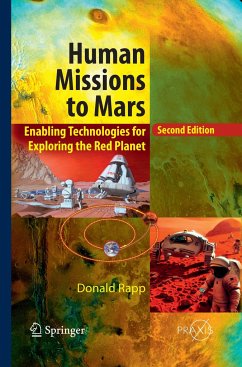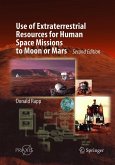A mission to send humans to explore the surface of Mars has been the
ultimate goal of planetary exploration since the 1950s, when von Braun
conjectured a flotilla of 10 interplanetary vessels carrying a crew of at
least 70 humans. Since then, more than 1,000 studies were carried out
on human missions to Mars, but after 60 years of study, we remain in the
early planning stages. The second edition of this book now includes an
annotated history of Mars mission studies, with quantitative data wherever
possible.
Retained from the first edition, Donald Rapp looks at human missions
to Mars from an engineering perspective. He divides the mission into a
number of stages: Earth's surface to low-Earth orbit (LEO); departing from
LEO toward Mars; Mars orbit insertion and entry, descent and landing;
ascent from Mars; trans-Earth injection from Mars orbit and Earth return.
For each segment, he analyzes requirements for candidate technologies.
In this connection, he discusses the status and potential of a wide range
of elements critical to a human Mars mission, including life support
consumables, radiation effects and shielding, microgravity effects, abort
options and mission safety, possible habitats on the Martian surface and
aero-assisted orbit entry decent and landing. For any human mission to
the Red Planet the possible utilization of any resources indigenous to
Mars would be of great value and such possibilities, the use of indigenous
resources is discussed at length. He also discusses the relationship of lunar
exploratio
n to Mars exploration.
Detailed appendices describe the availability of solar energy on the Moon
and Mars, and the potential for utilizing indigenous water on Mars.
The second edition provides extensive updating and additions to the first
edition, including many new figures and tables, and more than 70 new
references, as of 2015.
ultimate goal of planetary exploration since the 1950s, when von Braun
conjectured a flotilla of 10 interplanetary vessels carrying a crew of at
least 70 humans. Since then, more than 1,000 studies were carried out
on human missions to Mars, but after 60 years of study, we remain in the
early planning stages. The second edition of this book now includes an
annotated history of Mars mission studies, with quantitative data wherever
possible.
Retained from the first edition, Donald Rapp looks at human missions
to Mars from an engineering perspective. He divides the mission into a
number of stages: Earth's surface to low-Earth orbit (LEO); departing from
LEO toward Mars; Mars orbit insertion and entry, descent and landing;
ascent from Mars; trans-Earth injection from Mars orbit and Earth return.
For each segment, he analyzes requirements for candidate technologies.
In this connection, he discusses the status and potential of a wide range
of elements critical to a human Mars mission, including life support
consumables, radiation effects and shielding, microgravity effects, abort
options and mission safety, possible habitats on the Martian surface and
aero-assisted orbit entry decent and landing. For any human mission to
the Red Planet the possible utilization of any resources indigenous to
Mars would be of great value and such possibilities, the use of indigenous
resources is discussed at length. He also discusses the relationship of lunar
exploratio
n to Mars exploration.
Detailed appendices describe the availability of solar energy on the Moon
and Mars, and the potential for utilizing indigenous water on Mars.
The second edition provides extensive updating and additions to the first
edition, including many new figures and tables, and more than 70 new
references, as of 2015.
"This second edition of Donald Rapp's book is an impressive, comprehensive, and well-organized work that begins by exploring the history of the planning of human flights to Mars. ... There are three very comprehensive Appendices, which derive full statistical data for collecting solar energy on the Moon and Mars, and the quantities of water to be found on Mars at different localities (including a discussion of the topical 'slope lineae'). A Glossary completes the text." (Richard McKim, The Observatory, Vol. 136 (1253), August, 2016)
Aus den Rezensionen: "... Donald Rapp ... hat die Anforderungen an eine bemannte Mars-Mission aus unabhängiger Warte ins Visier genommen und realistisch - für manche Enthusiasten vielleicht sogar ernüchternd - analysiert. ... Das mit zahlreichen Tabellen, Diagrammen und Illustrationen ausgestattete ... Werk ist sehr faktenreich ..." (in: The Science Fiction Jahr 2008, 2008, S. 795 f.)
From the reviews:
"A skeptic's view on the realities of sending a human mission to Mars in the 21st century. ... Human Missions to Mars is hardbound, and Rapp's use of supporting formula, graphs, and technical illustrations ... make it clear that this volume is meant to be used as a reference book in research institutions, technical libraries, and scientific organizations. However, Rapp's engaging writing style and pragmatic view on this subject also makes it an interesting read for the armchair Mars explorer ... ." (Anthony Young, The Space Review, March, 2008)
"This book looks at human missions to Mars from an engineering perspective. ... The book includes appendices describing the use of solar energy on the Moon and on Mars and the value of indigenous water on Mars. This book was written for space scientists and engineers, intermediate-level undergraduates, and postgraduate researchers studying every aspect of human missions to Mars." (The Lunar and Planetary Information Bulletin, 2008)
"Rapp's book is a very readable, critical view of possible explorations of Mars. ... The book discusses in detail the many technologies that must be developed and demonstrated before a successful human mission to Mars can occur. ... The appendixes give significant details about solar energy and water on Earth's moon and Mars. The work is an excellent analysis of the difficulties posed by a human mission to mars. ... Summing Up: Recommended. Upper-division undergraduate through professional collections." (D. B. Mason, CHOICE, Vol. 45 (9), 2008)
"In this book, Donald Rapp ... sets out to provide a critical assessment of the requirements for human missions to Mars from an engineering perspective. ... I found it informative because I learned a lot about the intricacies of Mars mission architectures and the inherent engineering challenges. ... it is refreshing to read a detailed and independent study by someone who has no vestedinterest in any 'official' plans for human space missions." (Ian Crawford, Eos, Vol. 89 (36), 2008)
"A skeptic's view on the realities of sending a human mission to Mars in the 21st century. ... Human Missions to Mars is hardbound, and Rapp's use of supporting formula, graphs, and technical illustrations ... make it clear that this volume is meant to be used as a reference book in research institutions, technical libraries, and scientific organizations. However, Rapp's engaging writing style and pragmatic view on this subject also makes it an interesting read for the armchair Mars explorer ... ." (Anthony Young, The Space Review, March, 2008)
"This book looks at human missions to Mars from an engineering perspective. ... The book includes appendices describing the use of solar energy on the Moon and on Mars and the value of indigenous water on Mars. This book was written for space scientists and engineers, intermediate-level undergraduates, and postgraduate researchers studying every aspect of human missions to Mars." (The Lunar and Planetary Information Bulletin, 2008)
"Rapp's book is a very readable, critical view of possible explorations of Mars. ... The book discusses in detail the many technologies that must be developed and demonstrated before a successful human mission to Mars can occur. ... The appendixes give significant details about solar energy and water on Earth's moon and Mars. The work is an excellent analysis of the difficulties posed by a human mission to mars. ... Summing Up: Recommended. Upper-division undergraduate through professional collections." (D. B. Mason, CHOICE, Vol. 45 (9), 2008)
"In this book, Donald Rapp ... sets out to provide a critical assessment of the requirements for human missions to Mars from an engineering perspective. ... I found it informative because I learned a lot about the intricacies of Mars mission architectures and the inherent engineering challenges. ... it is refreshing to read a detailed and independent study by someone who has no vestedinterest in any 'official' plans for human space missions." (Ian Crawford, Eos, Vol. 89 (36), 2008)








